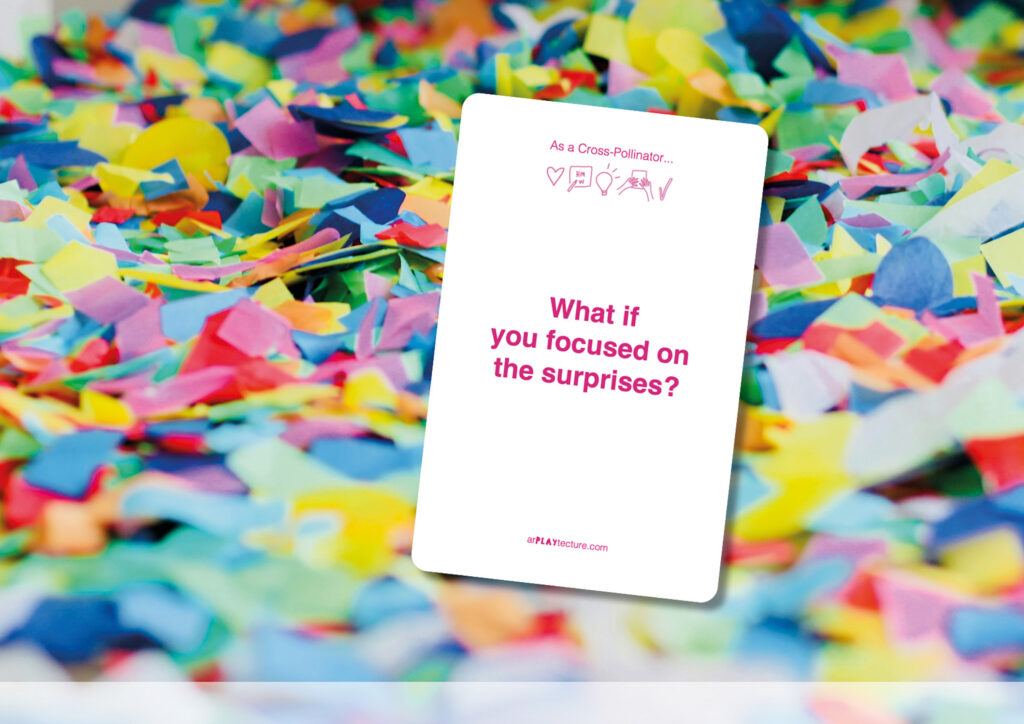In a world where predictability often reigns supreme, what if we embrace the unexpected? Challenge Card 021 from the Arplaytecture deck invites you to adopt this mindset:
As if you were a child, let yourself be surprised and inspired by unexpected user-related discoveries.
By taking on the Cross-pollinator role, this challenge invites you to question assumptions and embrace the unknown. Let’s examine how this card can influence in the five phases of the design process.
Empathise: Look for Contradictions and Hidden Insights
Start by observing and empathising with users. Look for moments that defy expectations:
When you spot a contradiction between what you see and what you expect, it’s a sign that you should dig deeper.1
For instance, if readers look bored at a library but look happy and engaged when reading on a bus, ask why.
Adopting a curious mindset will open the door to uncovering patterns that inspire unexpected ideas.
Define: Reframe the Problem around Surprises
Once you’ve gathered insights, shift from conventional to imaginative framing:
Instead of asking, “How can a library be more functional?” turn the question into a design opportunity, “How can we redefine the notion of reading in a public space?”
Surprises thrive when assumptions are removed. Reframing opens doors to unconventional solutions that resonate with users.
Create: Playfully Brainstorm Surprises
Brainstorm ideas that challenge norms and delight users:
What if the library’s staircase is transformed into an interactive artefact that recommends a reading depending on how you take every step up or down?
Could readers use playful furniture—like tree canopies or interactive installations, instead of conventional static tables and seats?
Push the boundaries by identifying contradictions and asking, “What’s the wildest twist we can imagine?” Let playful, bold ideas emerge.
Prototype: Let the Artefact Surprise You
Turn your ideas into tangible prototypes and play with them in unexpected ways. Use light, unlike materials. Turn the prototypes upside down; deconstruct them. Let the prototypes talk and tell you what they want to be.
You can even build a physical version of a surprising design element, like the canopies at the library.
Test: Observe the Reactions
When you test your prototype with real users, pay attention to their expressions and actions:
What do users say and don’t say?
Did the prototype spark joy, curiosity, or engagement?
How can the design evolve to maximise the impact of the unexpected?
Does their feedback surprise you in some way? Do they highlight something you hadn’t seen before?
Iterate on your findings, allowing the feedback to transform the surprise factor into the design driver.
The Power of Embracing the Unexpected
As Card 021 suggests: “To recognise these surprises, you must free yourself from your assumptions. The payoff is great: your solution will likely be innovative.”
Celebrate contradictions and dig into the unexpected.
Cultivating Surprises Through Cross-Pollination
The Cross-Pollinator role enriches this process by connecting surprises to diverse inspirations. By bridging unrelated concepts, you cultivate unique innovations.
Discover patterns and metaphors from varied fields:
How can an underwater environment inspire a sense of a floating promenade in a cultural space?
Could intuitive pedestrian flows in urban spaces inform circulation in public buildings?
Blend insights and disparate ideas to create transformative surprises:
Borrow strategies from how children arrange furniture when playing to design engaging co-working spaces.
Use modular seating innovations from small apartments to enhance public spaces.
Ultimately, the Cross-Pollinator narrows the challenge by explicitly linking the discovery of surprises to integrating diverse perspectives and techniques. This role demonstrates that surprises result from intentional exploration, creative connections, and openness to the unknown.
Cross-pollinators can create something new and better by unexpectedly juxtaposing seemingly unrelated ideas or concepts.2
Notes:

